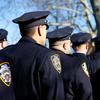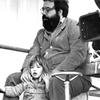Alex Goldmark appears in the following:
Federal Agency Ratchets Up Transit Push: Calculate Your Carbon Savings
Sunday, April 22, 2012
(Photo via the FTA)
As we reported earlier in the week, more than 80 percent of Americans drive to work alone. Now the Federal Transit Agency is ratcheting up its push to get more people out of cars and into buses (and trains too -- but that would have made for a tougher conceptual photo shoot to pull off).
(Widget not embeddable, so this is a screenshot.)
In preparation for Earth Day, the FTA has released a carbon calculator that tells you how much carbon you emit in a round trip to work. The FTA calculator assumes a commuter causes zero carbon emissions by joining on to existing public transit, which in a sense, is correct. A more accurate measure would be to evaluate the journey's pollution by emissions per passenger mile -- something a calculator on a widget couldn't easily do without knowing your own individual transit system's fuel efficiency.
Rest assured, if you drive to work your car is likely a major source of your environmental footprint, as the FTA points out:
"The average American produces 20 tons of CO2 per year, or 121 pounds per day. So, by taking existing transit rather than driving alone, for a daily commute of 10 miles each way, a person would save 4,600 pounds of CO2 per year (based on 240 working days per year). That is 2.1 metric tons, or about a 10% reduction in carbon footprint. By comparison, weatherizing their home and adjusting their thermostat would save a person about 2,800 pounds of CO2 per year."
Europe Loves Carpooling, Why Don't We?
Friday, April 20, 2012
(Photo (cc) by Flickr user Leo Reynolds)
Even in the worst traffic jam, our roads are still mostly empty. That's if you think about the car seats, not just the cars. For commutes, the average number of people per car in the U.S. was 1.1, according to 2008 data. That's a lot of unused capacity.
Or, as Odile Beniflah sees it, a millions of idle assets, wasted resources. She is working to launch Carpooling.com in America. Europe's largest ride sharing company used by 2 million people each month in 45 countries. And that's just through one website. It's cultural, she says. “People [share rides] first for the money, but they come back to it because they enjoy the experience, they enjoy the social aspect.”
The United States, on the other hand “has the largest network of empty seats on the planet."
Eighty-six percent of people ride to work alone. Just 10 percent of Americans carpool to work, including family members who ride together, down from a peak of 19.7 percent in 1980. For reference, about 5 percent take transit, and some people alternate modes. (Chart 8.15 here)
That’s because more people live alone, live farther away from easy pickup spots like parking lots near bridges and on-ramps, and don't go to the same places as their neighbors.
“In America, carpooling can only work if it’s convenient and easy,” Beniflah says after months of study to prepare for her company’s launch later this year. “The main reason Americans don’t carpool is the difficulty of finding someone else with the same location and schedule.”
Essentially, Beniflah says, Americans prioritize easy over cheap when it comes to travel. So it’s no surprise that the two “successful” U.S. carpool systems—in San Francisco and Washington, D.C—are flexible and convenient, what is known as casual carpooling. Riders wait at what are essentially taxi stands, then jump in with drivers who want access to HOV lanes or to save on tolls and gas without going out of their way. In 2009, these programs were used for about 3,000 trips a day, saving about 3 million gallons of gas a year.
So what will it take to get Americans offering rides to strangers?
Technology. Beniflah and a crop of other American entrepreneurs are hoping they can use online tools to match up empty seats with aspiring travelers. “I think you shouldn’t ride with strangers,” she says. Her service encourages reviews (like Couchsurfing.com uses for apartment sharing) to build trust, plus links to Facebook profiles and descriptions of the car to provide a full picture of whose empty seat you’re filling. “When you look at the ride offers, you really know who you are going to ride with, you have so much information." You can even pick the car type, or reserve a front seat. Riders and drivers set their own prices, and the company’s website plays matchmaker, taking a fee if users pay online.
Flinc integrates GPS navigation systems in cars and smartphones to connect people more efficiently. Zimride has been building a growing audience in the younger driver set -- a demographic less interested in owning or driving cars to begin with. Ridester is beta testing what its founders call a smart route-matching system.
All of them are trying to crack the puzzle and shift the mentality of thinking about giving someone a lift as a finding a potential road trip buddy instead of a hitchhiking ax murderer. By formalizing it online and using technology, Beniflah thinks, the U.S. could be more like Europe by tapping our idle asset of empty seats, economic efficiency is something we're supposed to be good at anyway.
A version of this post also appears in GOOD.
NYC Prize for Subway App That Works While Underground
Wednesday, April 18, 2012
 The top new transit app in NYC is now official, at least as far as government sponsored contests go. Embark won the MTA's app contest in February, and last night the trip planning phone application won the NYC BigApps competition in the mobility category.
The top new transit app in NYC is now official, at least as far as government sponsored contests go. Embark won the MTA's app contest in February, and last night the trip planning phone application won the NYC BigApps competition in the mobility category.
Last year, when NYC doled out $40,000 in prizes for apps that use government data in useful ways, transportation cleaned up with two of the top three. This year Embark was the lone tool for getting around to get a nod. (Full list of other winners).
While most trip planning tools require internet access to generate suggested routes, or tell you your travel time, Embark is designed to work underground while actually on the subway. So when the garbled overhead announcement threatens to ruin your plans with a delay or unexpected closure, you can whip out your phone to see what alternatives you have right there on the train.
Nest year, maybe we'll get an app for making your train switch to express when you're running late.
Who Took Those 1.6 Billion Subway Rides in 2011?
Wednesday, April 11, 2012
Subway ridership rose 2.3 percent in 2011. New Yorkers and city visitors took 1.64 billion trips, the most in any year since 1950.
Few Fatal Vehicle-Bike Crashes Lead to Arrest, Data Show
Monday, April 09, 2012
Killed While Cycling: Why So Few Fatal Bike Crashes Lead to Arrest in NYC
Sunday, April 08, 2012
A "bike lift" in silence during a memorial ride for killed cylists, March 2012 (Photo by Alex Goldmark)
Last year, 21 cyclists died in vehicle crashes in New York City. But only two drivers were arrested and local district attorneys are hard pressed to cite convictions for cyclist deaths. Instead, they say, cyclists and their advocates don't understand how tough it is to call a traffic crash a crime.
As far as intersections go, Bowery and Delancey is a pretty big one, eight lanes cross six. It’s never really empty, not even at 1:30 in the morning. It was that time of night about four years ago when Rasha Shamoon was fatally struck there by a Range Rover while riding her bike home.
As is standard procedure in traffic deaths in New York City, the police arrived and treated the intersection as a crime scene. They interviewed the three people in the car, but no other witnesses were mentioned in the police report -- several people had called 911 from the scene, but we'll never know if they saw the crash or not. Police determined Rasha Shamoon caused the crash and let the driver go.
Rasha's mother didn't buy the story. Samira Shamoon would later tell a New York city council hearing: “The first police report to the newspaper claimed that Rasha was at fault because she had run the red light and she was not wearing a helmet.” No helmet was found at the scene, but Rasha was known as obsessive on safety issues.
“Even the statement they got from the driver and his friends were not accurate and complete,” Samira Shamoon lamented. To get more information, she took the driver to civil court.
“We didn’t have any eye witnesses that said he was speeding," says Shamoon's lawyer, Adam White. "We didn’t have an accident re-constructionist, nothing in the police report that indicated rate of speed.” White used circumstantial evidence: Rasha's whole bike was covered in reflective tape, the passengers gave partially-conflicting accounts, and the 21 year-old driver had at least six previous moving violations.
"Ultimately the jury found that the driver was 95 percent at fault and it put 5 percent of fault on Rasha,” White said of the verdict handed down in February. The Shamoons were awarded $200,000.
The year Rasha Shamoon was hit, 2008, was the worst since 2000 for cyclist deaths: 26 people died. Last year, it was 21. But there were 27 times when a cyclist died, or was thought likely to die in NYC—that's how police categorize cases for record keeping. The NYPD tells WNYC of those 27 cases, two drivers were arrested. Looking at all cases where a driver kills someone -- pedestrian, cyclist, other motorists, themselves -- forty percent of the time, there’s not even a traffic ticket. Explaining why not, gets complicated.
Cyclist deaths in 2011 -- locations and dates from NYC DOT.
Bike advocates like Caroline Samponaro of Transportation Alternatives want the police to get tougher. If drivers cause crashes that kill, she told me, they should face serious consequences. “Even if you can’t prevent that crash, you can follow up and make sure that another crash like it doesn’t ever happen."
As cycling has taken hold in New York, and cases like Rasha Shamoon’s make their rounds on the bike blogs, something of a furor has risen up in the cycling community. Samponaro’s group organized protests outside police headquarters in November after another killed cyclist's family started criticizing the NYPD investigation.
Artist Mathieu Lefevre was hit by a truck in October in Williamsburg. The driver told police he did not know he hit anyone, so continued driving a few blocks before parking. No charges were filed because police determined both parties were at fault.
Erika Lefevre, Mathieu's mother, pressed for more investigation, and publicly complained the police withheld information from her, eventually filing a freedom of information request to see what the investigation report had found.
There were no photos from the scene because the police camera broke, according to the police report. And the only surveillance video from the scene doesn't show the crash.
I called the truck driver several times. When he didn’t return my calls, I went to his house to try to get his side of the story, but all he said was “no comment.”
As for the police, they say they're just following the law.
Sparked largely by the Lefevre case, the City Council held a four-hour hearing on traffic safety in February. “We realize that these are not just numbers on a piece of paper," NYPD Deputy Chief John Cassidy told angry council members and victims' family members. "And in my opening statement when I said one fatality is one too many, I seriously believe that,” he added.
The morning turned into a lesson in organizational charts, patrol guides and traffic law. The NYPD's most involved traffic investigations are handled by the Accident Investigation Squad. In 2000, there were 24 detectives. Now, because of budget cuts, there are 19. They handle the whole city.
So those detectives can only show up when someone dies or is declared likely to die by a medical professional. Asking them to handle more cases, or adding more detectives would be a policy choice, Cassidy said. “It would take resources away from other enforcement initiatives. One person can’t do two separate jobs at the same time.”
Those other initiatives include speed traps and DUI checkpoints. And, as Cassidy pointed out, traffic deaths are at an all time low. "So the accidents that you speak of," he told the council, "are not in fact occurring. So it’s not that we’re not doing anything out there. I think it’s quite the contrary -- we’re doing a lot with [a] lot less.”
I asked the police to explain how they determine when to make arrests, when to issue a ticket, and when to just let the driver go in a fatal crash with a cyclist. In an email, they said a motorist needs to break two traffic laws to rise to the level of criminal.
“Speeding alone will not produce criminality” the statement reads. “Passing a stop sign only will not provide for criminal charges. They will result in a speeding summons and a stop sign summons only, but together we have established a criminal charge of Criminally Negligent Homicide or higher.”
You'd need both to slap cuffs on a driver. And the police would need to witness speeding to prove it in most cases, they point out.
“We as a society have chosen to drive these big cars," said Joe McCormack, Assistant District Attorney for the Bronx. It’s his job to prosecute traffic crimes. "And we also as a society have chosen not to criminalize every single small mistake that just has a dramatic consequence because you're driving a car,” he said.
I asked all five district attorneys for an accounting of how many times someone who killed a cyclist was convicted of a crime. They all said they don’t track cases that way. But after much prodding for examples of what types of cases lead to jail time, the Queens DA cited two cases. In a 2009 case, a driver who had just sold heroin to an undercover officer was fleeing the scene when he struck and killed a cyclist. He was sentenced to seven-and-a-half to 15 years. In a 2006 drunk driving case, the motorist was sentenced to two-and-a-half to five years.
The Manhattan D.A. pointed to the case of Marilyn Dershowitz, sister-in-law of prominent lawyer Alan Dershowitz. The driver has been indicted. The case is pending.
The Brooklyn D.A. has brought three cases where bicyclists died in the past two years. All got convictions. Two were prosecuted as aggravated unlicensed driving charges. The third death case was tried as a manslaughter but ended with a jury trial conviction of driving with a suspended license.
Only one cyclist died in the Bronx last year. It was a hit and run. The driver was never found.
“There are times where the factual situation that is presented to us doesn’t rise to a crime," McCormack said. "And it’s important to realize that the reason it doesn’t rise to a crime is that society has made that decision that it doesn’t want it to be a crime.”
Some in society do.
When the weather warmed last month, a couple hundred cyclists held a memorial ride to honor the 21 bike riders who were killed on city streets last year. They placed white painted ghost bikes at the site of each crash. Read a statement in front of the 90th Precinct where four cyclists were killed last year, including Lefevre. And rang their bike bells the the backdrop of a bagpipe.
Those 21 deaths, they say, are 21 too many. On that, the police agree.
Audio of protest used with permission from Streetfilms. In addition to our map above, cyclist deaths from other years are tracked and mapped at Ghostbikes.org
California High Speed Rail To Cost a Third Less
Monday, April 02, 2012
A rendering of California's high-speed rail (image courtesy of California High-Speed Rail Authority)
Better, Faster, Cheaper? That's the promise being pushed by the agency in charge of California's ambitious high-speed rail project as it unveiled an updated business plan for the ambitious project to connect Los Angeles and San Francisco by bullet train. The California High-Speed Rail Authority released an updated business plan that now puts the price tag at $68.4 billion with a completion in 2028.
That's about five years sooner and $30 billion cheaper than a draft plan released last fall that drew wide criticism as a potential boondoggle. The new cost is still $25 billion more than the plan approved by voters four years ago in a referendum to allow the issue of bonds to finance the project.
The new business plan was created at the behest of Democratic Governor Jerry Brown who has remained a steadfast supported of high-speed rail unlike Republican governors in Wisconsin and Florida. Some lawmakers questioned the convenience of the new estimates in the updated business plan.
Some of the cost and time savings will come from a "blended" approach to rail construction, merging the new bullet trains with existing commuter lines. It would involve upgrading commuter rail in L.A. and in the San Francisco Bay Area while building the initial HSR line in the Central Valley as planned using federal funds. Los Angeles gets linked to the Central Valley first, then San Francisco in a following phase.
To pay for it CAHSRA wants to use "cap and trade" revenues as a potential "dedicated funding source." Private investment continues to be spotlighted as a major source.
with Julie Caine -- KALW, and Associated Press
The History, and (Questionable) Future of Pittsburgh's Public Transit
Friday, March 30, 2012
(Photo (cc) by Flickr user: Amphis d'@illeurs)
Like many cities, Pittsburgh is fending off steep transit cuts.
To catch you up on the stakes in Pittsburgh, the Port Authority, the agency in charge of public transit needs money, about $64 million. In January, it announced a plan to cut 35 percent of overall service, from 102 down to 56 transit lines. Late-night and weekend service would be severely curtailed as well. The cuts are set to take effect in September.
The folks at WRCT Radio in Pittsburgh have tried to figure out how their city's bus system came to be a the brink of breakage despite average population density and spending for other cities with similar service.
In their hunt for transit funding answers, WRCT does an admirable job turning to history for insight. Listen as they board an antique streetcar (within a history museum) to compare a transit map from 1950 -- when the system was privately run -- to the current map, as the public agency in charge of Pittsburgh's mass transit contemplates cutting 46 lines.
From there they hear from a bevy of experts on how streetcars became bus routes and a private streetcar enterprise became a public good that got short shrift in funding battles. Download it as a podcast and take it with you on your next ride around town: it's a two part series, each part is 30 minutes long.
Audio and full article at WRCT.
Syria Accepts UN Plan that Includes Daily Ceasefire
Tuesday, March 27, 2012
Mexico City's BRT Rolls on Through Earthquake, Subway Not So Much
Friday, March 23, 2012
(Photo (cc) by Robin Murphy, World Resources Institute, 2007)
A 7.4 magnitude quake hit southern Mexico Tuesday, and shook ground 200 miles away in the capital city hard enough to collapse bridges and mangle subway lines. But Mexico City's bus rapid transit system kept rolling, with some delays, according to El Universal (link is in Spanish).
When subway rails are damaged, as happened in the Mexico City quake, whole lines can be crippled. But BRT can continue to run wherever the roads hold up. Mexico City's BRT runs Volvo diesel articulated buses. Some BRT stations experienced power outages that did not disrupt the system's functioning after Tuesday's quake.
Mexico City is no stranger to quakes after a devastating 8.0 temblor in 1985 killed 10,000 people. This one, much smaller, claimed only two lives. New buildings in the capital are constructed to withstand earthquakes and held up well. The subway, cleverly designed as it is, is old construction. BRT is the innovation in this pair. The system is by design -- and now by field test -- ready for earthquakes.
For more on BRT, see our series from 2009.
LaHood's Latest Web Video Has Gentler Words on House Transpo Bill
Friday, March 23, 2012
 Ray LaHood is keeping up his usual drumbeat issues in his latest web video in his On The Go series.
Ray LaHood is keeping up his usual drumbeat issues in his latest web video in his On The Go series.
LaHood used a question submitted from Facebook about transportation grant funding to comment on transportation funding bills under debate in Congress. Hard to imagine there wasn't a more direct question about the bills, but nonetheless LaHood couldn't keep from a short show of support for the Senate's version of the transportation bill, calling it "very good" and "truly bipartisan."
LaHood is notably diplomatic when referring to the House transportation bill, in fact, downright kind compared to his previously blunt language. He says "we are going to be working with the House to either pass the Senate bill" ... or ... he doesn't say or what. We're left wondering what he'd work with House GOP leaders to craft besides that.
The rest of the video offers a few hints on where the DOT is thinking ahead on safety.
"We're continuing to do research" on whether GPS distracts people from driving, he says. He points out the DOT has already suggested voluntary guidelines for carmakers that install built-in GPS systems. LaHood wants the devices programmed to disable the controls while the car is in motion. "We hope that they [the carmakers] will do that," was all he said on the likelihood of that kind of governor setting coming to be. No regulations are in the works.
Watch the full video here:
Peace and Reconciliation: A Path Forward for Ireland
Monday, March 19, 2012
Politicians from both sides of the Irish border will be in Washington tomorrow to help President Obama celebrate a belated St Patrick's Day. A symbol of the progress since the signing of the Good Friday Agreement in 1998, but back home divisions still run deep. Few are willing to confess the role they might have played in past violence. But former Loyalist and Republican paramilitaries are looking for a way forward, a journey that's taken them to the townships of South Africa.
How Fit Do You Have to Be to Fight Crime?
Friday, March 16, 2012
John Hockenberry joins us from London, where people are talking about fitness for police officers. After a survey found that 53 percent of officers were overweight and one in 100 was morbidly obese, new proposal in England and Wales would require officers to undergo an annual fitness test. Penalties could include paycuts for those who repeatedly fail -- all as a way to reportedly "rid the service of fat officers".
Forty Years Ago: The Godfather Premieres
Thursday, March 15, 2012
The Godfather defined a movie genre and defined the mafia criminal enterprise headed by a godfather who ruled like a pharoah, murdered his enemies and was a gentle grandpa to his family. That movie premiered 40 years ago today in New York, the city where it is largely set. From London John Hockenberry spoke with Federico Varese, professor of Criminology at Oxford University and author of "Mafia on the Move," about the accuracy of the mafia portrayal in the classic film.
John Hockenberry Reports from London: Encyclopedia Britannica to Stop Print Editions
Wednesday, March 14, 2012
After 244 years, the oldest continually published encyclopedia in the English language, the Encyclopedia Britannica, is going out of print. The encyclopedia will now be focused on its online edition and educational curricula for schools. John Hockenberry reports from London, where he spoke with the encyclopedia's managing editor Ian Grant.
John Hockenberry on the "Design of the Year" Nominees
Tuesday, March 13, 2012
John Hockenberry reports from London, where he visited the UK's National Design Museum to view the "design of the year" nominations on display. With more than 80 entries in seven categories, the designs included a life-size paper hearse and a plan for a hospital in Rwanda that benefits the community.
Peer-to-Peer Car Sharing Is National as of Today
Monday, March 05, 2012
(Screen grab from RelayRides)
Until today, if you wanted to rent out your car for the hour, you had to do it on your own. Not so easy to create that market, especially in smaller towns and rural areas. But RelayRides, the first company to try peer-to-peer car sharing two years ago, has just become a national company as of this morning.
"For us, with our model, it does work for us to work in a rural area,” Shelby Clark CEO of RelayRides tells Transportation Nation. His company's website is meant to match renters and car owners and create the fluid market needed to turn a parked car into a business. “I'm excited to see what happens when we move out to areas that do not have car sharing."
Right now, his company has 200 cars up for rent, used by 6,000 borrowers in Boston and San Francisco. Clark said that "thousands" of people from other areas have signed up on his website to rent or borrow even though the service was only offered in those two cities.
His peer-to-peer model is different from the Zipcar model because RelayRides doesn't own any cars. All it does is connect car owners with renters. That means that it can conceivably work in even very remote places bringing a transportation option to people who have no option but to own a car or hitch a ride even. It hasn't been tried yet, so there's no proof the idea will work outside of urban areas.
Peer-to-peer car sharing has been most popular where traditional car sharing thrives: close to transit and with wealthy people who choose not to have a car. In fact, Clark says, a college education is the biggest predictor of car share membership. “We haven't seen any strong trends so far in terms of where adoption will be strong outside of these traditional car share markets," Clark says, eager to find out.
The prospect of turning a car into a small business though, could drive more people to rent out their wheels. Rentals prices are set by the owner at anything above $5 per hour and $25 per day. The average RelayRides car owner earns $250 a month.
There could be a snag with insurance. Most residential insurance doesn't cover commercial activity in your car. Renting it out, even to neighbors, is commercial. However, in the two years of experience so far, it doesn't seem that's how insurance companies are treating the practice. Nobody has been dropped, Clark says. Still, three states, California, Oregon and Washington, have all passed laws to explicitly make peer-to-peer car sharing legal.
Clark says aach shared car can take 14 cars off the road, or off the driveway anyway.
Buy Your Own Authentic Wooden Subway Benches
Friday, March 02, 2012
 When is it worth paying $650 for a 30-year-old uncomfortable bench designed to prevent laying down? When it's subway history!
When is it worth paying $650 for a 30-year-old uncomfortable bench designed to prevent laying down? When it's subway history!
The New York Metropolitan Transportation Authority is making "a select number" of the iconic platform furniture pieces available for sale as they switch to metal benches, which are cheaper to maintain.
The MTA posted on this sales pitch on it's website:
"Every wooden bench comes directly from the New York City Subway system and will come with its own certificate of authenticity. The benches are 10'7" wide, 1'8" deep, 2'7" tall and are designed to seat six people."
Place your order here. Just don't ask what has spilled on it since 1980 ... or bed bugs.
GM Halts Production of Chevy Volt for Five Weeks Due to Poor Sales
Friday, March 02, 2012
Image: © GM Corp
Chevy Volts aren't selling well. The Detroit Free Press reports that GM is shutting down the Volt plant in Michigan for five weeks to avoid an oversupply of the electric/combustion combination car that GM has invested heavily to market.
As the automaker bounces back from bankruptcy the Volt was meant to signal a new, cleaner, innovative era for General Motors. But after initial hype and design awards, the company has only sold about 7,600 Volts, far less than the 10,000 GM projected, according to the Free Press.
GM will temporarily lay off 1,300 employees at its Detroit Hamtramck plant from March 19 to April 23.
“The fact that GM is now facing an oversupply of Volts suggests that consumer demand is just not that strong for these vehicles." Edmunds.com Chief Economist Dr. Lacey Plache said. "The price premium on the Volt just doesn’t make economic sense for the average consumer when there are so many fuel-efficient gasoline-powered cars available, typically for thousands of dollars less.”
The Nissan Leaf, an all-electric car, has a waiting list of about 26,000 people, according to AutoBlog but has sold just 800 cars per month on average, which is more than the Chevy Volt.
NY Ports Chief Calls Docks Bastions of Discrimination, Vows Action
Friday, February 24, 2012
The head of the Port Authority of New York and New Jersey wants to use the agency's clout as landlord to get more dock workers of color hired.

















